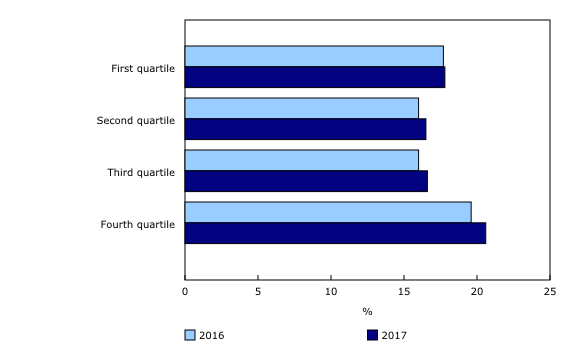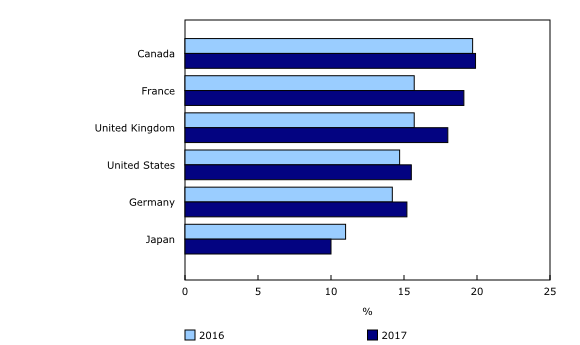Representation of women on boards of directors, 2017
Archived Content
Information identified as archived is provided for reference, research or recordkeeping purposes. It is not subject to the Government of Canada Web Standards and has not been altered or updated since it was archived. Please "contact us" to request a format other than those available.
Released: 2020-01-28
Today, Statistics Canada is releasing new data on the gender composition of corporate boards in Canada in 2016 and 2017. These data highlight women in leadership and strategic decision-making roles in corporations conducting business in Canada. These data also support gender-based analysis across government and private sector organizations.
This study was produced in partnership with Statistics Canada's Centre for Gender, Diversity and Inclusion Statistics. Additional information about the Centre and other gender-related studies and statistics can be found in the "Gender, diversity and inclusion statistics" hub.
Directors sit on a board of directors, the governing body of a corporation. Generally, directors are responsible for the decision-making and supervision of the activities of a corporation.
The dataset for the reference year 2017 contained 10,108 corporations and 31,266 directors. Among the 31,266 director seats, 18.1% were held by women, a slight increase from 2016 when 17.8% of the 30,486 directors were women. The majority of boards included in the analysis were composed entirely of men in both 2016 (61.7%) and 2017 (61.2%). The proportion of boards with one female director increased from 26.6% in 2016 to 27.7% in 2017, while boards with more than one female member made up over one-tenth of the dataset in both 2016 (11.7%) and 2017 (11.1%).
Only a minority of the boards that were analyzed showed an increase in the number or proportion of seats occupied by women in 2017 compared with 2016. Of the 8,670 firms present in both years of data, 6.4% saw an increase in the number of women on their boards and 8.6% saw an increase in the proportion of women on their boards.
Among the director positions included in the 2017 dataset, 24,422 were present in 2016 as well, while 6,844 were first recorded in 2017. The representation of women was higher among newly recorded director positions, with women occupying 19.2% of those seats, compared with 17.8% of the director seats present in both years.
Corporations operating in the utilities industry have the highest share of women directors
The utilities industry had the highest representation of women in both 2016 (22.3%) and 2017 (24.6%). It also was the industry with the highest year-over-year increase. Representation of women in the finance industry remained in second place with 21.9% in 2016 and 23.3% in 2017, while the management of companies and enterprises industry continued to be in third place, with 18.8% in 2016 and 19.3% in 2017.
From 2016 to 2017, representation of women on corporate boards increased in all industries except manufacturing, where the share of women directors remained stable at 13.1%.
Although the representation of women on boards of firms in the construction industry increased from 12.5% to 13.6%, companies operating in the construction and manufacturing industries had the lowest shares of women directors in both 2016 and 2017.
The boards of the largest corporations display the highest levels of representation of women
Assets, which refer to all the resources owned by corporations, are considered a good indicator of a corporation's size. The proportion of women directors was higher in 2017 compared with 2016 across all size quartiles and the larger the size of the corporation, the more significant the increase in representation.
In both 2016 and 2017, women were most represented on boards of directors for the largest and the smallest corporations in terms of assets, that is, corporations in the fourth and first quartile, respectively. Among boards for the largest firms, the representation of women rose from 19.6% to 20.6%. The share of women directors was 17.7% in 2016 and 17.8% in 2017 for the smallest firms' boards.
For both 2016 and 2017, boards tended to increase with corporation size and a larger board was associated with a higher likelihood of having at least one woman director across all size quartiles. Among boards composed of at least three directors, the largest corporations had the highest proportion of boards with at least one woman director in 2016 (60.0%) and 2017 (63.0%). Conversely, among the smallest companies with three or more directors, just under half had one or more women on their board in 2016 (49.6%) and 2017 (49.5%).
The higher representation of women among the fourth and the first quartiles also reflects industry composition. In both years, finance firms were most prevalent in the largest and the smallest quartiles, while firms in the management of companies and enterprises industry were highly represented among fourth quartile corporations. Together, entities operating in these two industries made up about half of the fourth quartile corporations in 2016 (49.3%) and 2017 (51.3%).
Corporations controlled by Canadian entities have the highest share of women on their boards
Firms controlled by Canadian entities represented 57.4% of the dataset in 2016 and 55.8% of the dataset in 2017. Their boards displayed the highest proportion of women directors in 2016 (19.7%) and 2017 (19.9%), followed by those of France-controlled entities and United Kingdom-controlled entities.
Boards of France-controlled entities saw the highest year-over-year increase in the representation of women, with the proportion of women directors rising from 15.7% in 2016 to 19.1% in 2017. United Kingdom-controlled entities followed, with a share of 15.7% women directors in 2016 and 18.0% in 2017.
Representation was the lowest among Japanese-controlled entities in both 2016 and 2017, falling from 11.0% to 10.0% from one year to the next.
These results seem consistent with statistics on directorships held by women globally, which show higher representation in France and lower representation in Japan.
Women most likely to hold board seats in government business entities
In both years, government business entities had the highest levels of representation of women, with the share of women directors rising from 27.7% in 2016 to 35.2% in 2017. This was the most significant year-over-year increase observed across all types of enterprises. Publicly-traded corporations followed, increasing from 20.3% in 2016 to 21.3% in 2017. The proportion of women on the boards of privately-held corporations edged up from 17.4% in 2016 to 17.7% in 2017.
Note to readers
Data sources and methodology
The Corporations Returns Act (CRA) program collects financial and ownership data on corporations conducting business in Canada for public, private, and government businesses. Corporations are included in the sample if their gross revenues for a fiscal period exceed $200 million, their assets exceed $600 million or their long-term debt or equity owing to non-residents exceeds a book value of $1 million.
However, while these data are used to understand domestic and foreign residence of corporate board members, they cannot provide information on the gender profile of these individuals.
To identify the gender of these corporate board members, a two-step process was undertaken.
First, the data were integrated, where possible, with gender data from the Derived Record Depository, a national dynamic relational data base containing only basic personal identifiers of Canadians built by integrating information from administrative data files available at Statistics Canada, including the T1 Personal Master file, for the purpose of facilitating the integration of data from other files.
Then, for the records which could not be integrated, probabilistic imputation was employed using information available about the corporate board members.
The data obtained through the CRA program are used to evaluate the extent of foreign control in the Canadian economy and are summarized in an annual report to Parliament. To release information from the CRA program, Statistics Canada must receive the approval from Parliament.
The corporations targeted by the CRA represent a subsample of the total population of incorporated enterprises operating in Canada which are included in the Annual Financial and Taxation Statistics for Enterprises (AFTS). The CRA publishes statistical estimates at the legal entity level, while the AFTS disseminate statistical estimates at the enterprise level. Since the AFTS assets are consolidated, there is an overrepresentation of assets in the CRA when compared to the assets in the AFTS.
References
Information on the representation of women on corporate boards in other countries was taken from Catalyst, Quick Take: "Women on Corporate Boards" (December 21, 2018).
Revision policy
Statistical revisions are carried out annually to incorporate the most current information available. Generally, these revisions are limited to the previous reference year.
Periodically, comprehensive revisions could be conducted, which would generally entail revisions beyond the scope of the standard revision window. These provide an opportunity to enhance estimation methods and incorporate improved data sources and concepts.
Sources of revisions
The revisions to data for reference year 2016 mostly came from an update of the 2016 dataset and from methodological enhancements. These revisions are described below.
As a result of these revisions, new benchmark information is available with the use of additional sources, notably, the use of tax data information to ensure units consistently met the inclusion criteria of the Corporations Returns Act. Furthermore, we removed units that were inactive within the reference year based on administrative data files and removed units that reported tax revenues lower than $30,000. We also reviewed our classification of publicly traded corporations by solely assigning this classification to the corporations which issue publicly traded shares.
Impact of the revisions
Data on the gender of board directors for reference year 2016 was revised from 44,658 to 31,883 directors. The proportion of women board directors for the reference year 2016 was revised down to 17.8% from 19.4%. While the proportion of women has decreased 1.6% from our previously released numbers, the growth rate of director seats held by women was up 0.3%.
Contact information
For more information, or to enquire about the concepts, methods or data quality of this release, contact us (toll-free 1-800-263-1136; 514-283-8300; STATCAN.infostats-infostats.STATCAN@canada.ca) or Media Relations (613-951-4636; STATCAN.mediahotline-ligneinfomedias.STATCAN@canada.ca).
- Date modified:





